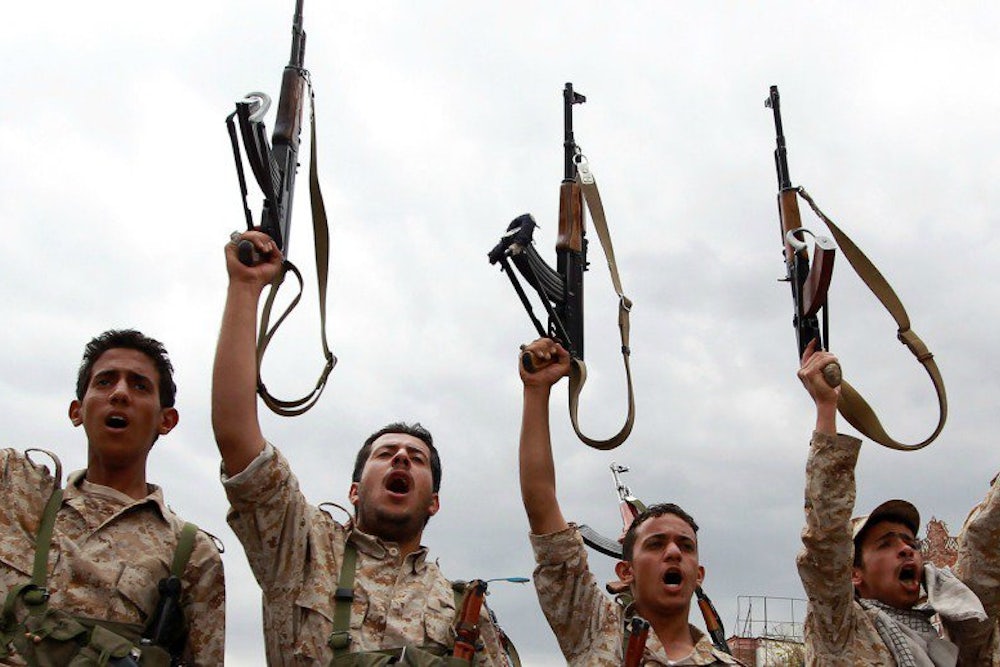Since March 26, a Saudi-led coalition of Sunni countries has been carrying out airstrikes against Houthi rebels in Yemen. The Houthis, a Zaydi Shiite group which has received support from Iran, have aligned themselves with former dictator Ali Abdullah Saleh to challenge the rule of the internationally recognized President Abd-Rabbu Mansour Hadi. At Sunday's Arab League summit in Egypt, Hadi made no secret of the sectarian lens through which he and his Sunni allies view the conflict, calling the Houthis “stooges of Iran.”
Some American lawmakers have followed suit. “We call them Houthis. But this is Iran,” North Carolina Sen. Richard Burr said Sunday on CBS' "Face the Nation." On the same program, California Congressman Adam Schiff argued that the U.S. must support the Saudi initiative to prove its willingness to “confront Iran as it tries to expand its quite nefarious influence throughout the region.”
But viewing the conflict in Yemen through this narrow sectarian prism oversimplifies the complex political landscape within Yemen. More importantly, framing the conflict in terms of Sunni vs. Shia can be a self-fulfilling prophecy. In the current cold war going on in the Middle East, between Sunni Saudi Arabia and Shiite Iran, it could force armed actors to entrench themselves further on one side of the divide.
The Houthis practice a form of Shiite Islam—Zaydism—that exists almost exclusively in Yemen and is closer to Sunni Islam than the Twelver Shiism dominant in Iran. Most Yemeni Sunnis belong to a branch known as Shafii. Stephen W. Day, a Yemen expert and author of Regionalism and Rebellion in Yemen, argues that the conflict is defined mostly by regional and tribal divisions within Yemen. “Across history the Zaydi-Shafii distinction is actually a regional political division between influential groups in mountain highlands on one hand, and all others,” Day said. “Yemenis in all regions ... feel that current fighting has less to do with Zaydi-Shafii than traditional highland mountain people asserting their dominance over others.”
Adam Baron, a visiting fellow at the European Council on Foreign Relations who reported from Yemen for several years, agrees that sectarianism has not been a driving factor in Yemen’s domestic power struggles. “There has always been some sectarian element to the conflict, but it's been comparatively minor when it comes to fueling the current morass,” he said in an email. Over the last several decades, Saudi behavior in northern Yemen—where most Zaydis live—played a significant role in the rise of the Houthis. To spread their influence in the Arabian Peninsula, the Saudis started supporting conservative Wahhabi/Salafi schools and mosques, provoking a Zaydi revivalist response. Baron said that “the import of sectarian, hardline Sunni ideologies had a part in birthing the Houthi movement … even if the Houthi movement has long ago moved to transcend the sectarian identity of its leaders.”
But the more the Saudi coalition treats the Houthis—who, it should be noted, have been fighting in alliance with Saleh-loyal Sunni military units and tribesman—like Iranian proxies, the greater the chance this conflict will turn into a protracted sectarian war. While few analysts believe Iran has any direct control over the Houthis, it has provided financial support and military training. Last month, the Iranians promised them a year’s supply of oil. If the Saudi coalition continues to seek a military solution to a political problem, Houthi reliance on Iran could increase and turn a largely domestic conflict into another regional battleground. According to Day, the Saudi-led intervention could be the catalyst which changes Yemen’s “mild” sectarianism. “I worry about Yemen changing permanently in its character, but I don't think we have yet crossed that point of no return.”
There are precedents here. Perhaps the most familiar example of the self-fulfilling nature of these sectarian narratives is the U.S. handling of Iraq after the overthrow of President Saddam Hussein. As journalist Nir Rosen has argued, the Coalition Provisional Authority’s treatment of Iraqi people as minority groups to be pitted against one another contributed to the various communities’ divisions and the bloody Sunni-Shia civil war in 2006 and 2007. Now, Iraq is dominated by ISIS and Iranian-backed Shiite militias.
Ultimately, it is not Saudi Arabia, Iran, or their ideologies, but the Yemeni people who are the real losers in this conflict. They have been tweeting with the hashtag #KefayaWar—Enough War—as civilian deaths mount. The conflict has disrupted food shipments to the country, which is heavily dependent on imports. The UN High Commissioner for Human Rights has said that Yemen is on the “verge of total collapse.”
“Rather than talking about the blame game when we talk about Iran and Saudi Arabia fighting each other, there are millions of people stuck between these names,” Yemeni analyst Sama'a Al-Hamdani said at a briefing Thursday hosted by the National Council on U.S.-Arabs Relations. “How can you curb an ideology by launching airstrikes against the people?”
